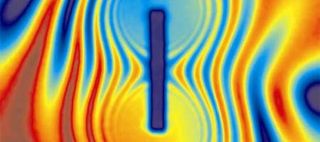Scientists Develop Method To Create 3D Images Of Magnetic Fields
Berlin (Germany) - Remember drawing images of magnetic fields in physics class? Scientists from Hahn-Meitner-Institute (HMI) and the University of Applied Sciences, both located in Berlin, Germany, in Berlin have developed a much more sophisticated way to show actual magnetic fields in solid materials by visualizing the quantum-mechanical spin state of neutrons.

Despite the fact that first magnet observations were made more than 1000 years ago and that it has been explained more than 400 years ago that the Earth represents a huge magnet, the characteristics of magnets largely remain a mystery to many people, at least what is beyond the function of a compass needle.
In high school, you may have been to the basic nature of magnets as well as some experiments explaining magnetic fields during physics class in high school. Those schematic circular drawings of magnetic fields just got a boost with a new imaging method that can yield 2D and 3D imagery of existing magnetic inside solid materials.
In an article published in the March 30 issue of Nature Physics, a research group led by Nikolay Kardjilov presented a new visualization approach that takes advantage of the zero net charge and magnetic characteristics of neutrons. According to Kardjilov, neutrons in a magnetic behave like compass needles, aligning to the direction of the field. Neutrons also have an internal angular momentum, often referred to by physicists as spin, a property that causes the needle to rotate around the magnetic field, similar to the way in which the Earth rotates on its axis.
When all of the magnetic moments point in the same direction, the neutrons are described as being "spin-polarized". If a magnetic sample is irradiated with such neutrons, the magnetic moments of the neutrons are rotating around the magnetic fields they encounter in the sample and the direction of their spin changes, the scientists said.
Kardjilov groups used these characteristics to develop a visualization technology based on radiographic and tomographic imaging, which reveal the quantum-mechanical spin state of neutrons caused by magnetic fields in and around bulk objects. He believes that the images will show "previously inaccessible magnetic field distributions" and close "the gap between high-resolution two-dimensional techniques for surface magnetism and scattering techniques for the investigation of bulk magnetism." His research was conducted on a "massive sample of lead" of a type-I superconductor with the goal to study quantum effects.
The findings could not help improve magnetic field applications in medicine, such as magnetic field therapy, but a greater understanding of the invisible lines of magnetic force can also impact energy areas such as the production and transmission of electricity, high-temperature superconductivity, as well as magnetic shielding systems for electron microscopy and e-beam lithography.
Stay on the Cutting Edge
Join the experts who read Tom's Hardware for the inside track on enthusiast PC tech news — and have for over 25 years. We'll send breaking news and in-depth reviews of CPUs, GPUs, AI, maker hardware and more straight to your inbox.
Most Popular






